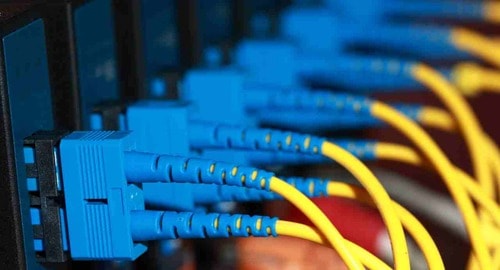
In the fast-paced digital age, where information travels at the speed of light, fiber optics emerges as a revolutionary technology that drives our interconnected world. In this article, we’ll delve into the intricacies of fiber optics, exploring its inner workings, applications, and profound impact on modern communication.
Understanding Fiber Optics
Fiber optics, at its core, is a technology that transmits data through thin strands of glass or plastic fibers using light as its carrier. It departs from traditional electrical transmission, offering unparalleled speed and efficiency.
The fundamental principle of fiber optics lies in total internal reflection. Light entering the fiber’s core at a specific angle continuously reflects off the cladding, ensuring minimal signal loss and enabling data to travel long distances.
How Fiber Optics Work
A fiber optic cable consists of a core where light travels, surrounded by a cladding with a lower refractive index. This contrast in refractive indices allows for total internal reflection, confining the light within the core and preventing leakage.
Data is transmitted through fiber optics using optical signals, which can represent complex information through variations in light intensity. This process involves using lasers or light-emitting diodes (LEDs) to generate light pulses that encode the data.
Advantages of Fiber Optics
Blazing-Fast Data Transfer Rates: One of the most prominent advantages of fiber optics is its remarkable speed. With data rates surpassing traditional copper cables by leaps and bounds, fiber optics facilitate seamless streaming, rapid downloads, and lag-free online experiences.
Immunity to Electromagnetic Interference: Fiber optics are immune to electromagnetic interference. This makes them highly reliable in environments prone to electrical noise, ensuring consistent and stable data transmission.
Long-Distance Communication Made Possible: Fiber optics enable long-distance communication without compromising signal quality. The minimal attenuation of light ensures that data can traverse thousands of kilometers with minimal loss, making it invaluable for global communication networks.
Applications of Fiber Optics
Telecommunications: Backbone of Global Connectivity: Fiber optics form the backbone of modern telecommunications networks. They enable the transmission of huge amounts of data, including voice calls, video conferencing, and internet traffic, connecting people across the globe.
Internet Revolution: Enabling High-Speed Browsing: The fiber optic revolution has paved the way for high-speed internet connections, transforming how we browse, stream, and interact online. Fiber-optic broadband offers unparalleled speed and reliability, enhancing user experiences.
Medical Field: Endoscopes and Surgical Imaging: Fiber optics play a crucial role in endoscopic procedures and surgical imaging in the medical field. The flexibility of fiber optic cables allows for non-invasive internal examinations and precise imaging during surgeries.
Industrial and Defense Sectors: Secure Data Transfer: Industries and defense sectors utilize fiber optics for secure data transmission. Their immunity to eavesdropping and electromagnetic interference makes them ideal for transmitting sensitive information and maintaining communication in critical situations.
Fiber vs. Traditional Copper Wiring
Bandwidth and Speed Comparison: Fiber optics outshine traditional copper wiring when it comes to bandwidth and speed. While copper struggles to keep up with increasing data demands, fiber optics provide ample bandwidth for today’s data-hungry applications.
Durability and Maintenance: Fiber optic cables are faster and more durable than traditional copper wires. They are immune to weather conditions and corrosion, that results in lower maintenance costs and increased reliability.
Future Innovations in Fiber Optics
Quantum Fiber – Revolutionizing Encryption: The advent of quantum fiber holds the promise of unparalleled data security. Quantum key distribution through fiber optics ensures unbreakable encryption, safeguarding sensitive information from cyber threats.
Integrated Photonics – Merging Optics and Electronics: Integrated photonics is a groundbreaking technology that combines optics and electronics on a single chip. This innovation opens doors to more compact, energy-efficient, high-performance application devices.
Overcoming Challenges
Installation Costs and Complexity: Despite its numerous advantages, the initial installation costs of fiber optics can be relatively high. The delicate nature of the cables and the expertise required for installation add to the complexity.
Vulnerability to Physical Damage: Fiber optic cables, while robust, can be susceptible to physical damage, such as bending or crushing. Safeguarding these cables during installation and maintenance is essential to maintain uninterrupted communication.
Conclusion
Fiber optics are a beacon of technological advancement, revolutionizing how we transmit and receive data. Their incredible speed, immunity to interference, and diverse applications make them the backbone of modern communication systems.

Leave a Reply